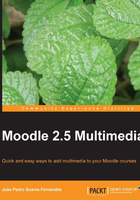
What this book covers
Chapter 1, Getting Ready for Multimedia in Moodle, takes a look at the evolution of multimedia, its advantages and uses in teaching and learning, and how these can be used with Moodle. We will also see some of the requirements for using multimedia in Moodle, and configure it accordingly. We will make three simple experiments in a forum with pictures, sound, and video, to see if everything is working as expected while integrating these in Moodle.
Chapter 2, Picture This, deals with images, so we will look at different ways of finding and inserting images in Moodle. We then learn about image editing tasks, commented screenshots, and comic strips. We will also learn how to export presentations as images, adding them to a Moodle lesson, or as an alternative, publishing these presentations in an online service.
Chapter 3, Sound and Music, focuses on tasks for the Moodle integration of sound and music elements. The resources created will make information available in improved ways to students, and will also get them to create audio works, such as soundtracks, slices, remixes, voice recordings, text-to-speech, and podcasts.
Chapter 4, Video, focuses on video production and editing, looking at different ways of using these in Moodle. We will start by looking at places to find free videos online, find ways of downloading videos from online services, extract DVD selections, create photo stories, screencasts, online TVs, and stop motion videos.
Chapter 5, Understanding Web-based Applications and Other Multimedia Forms, focuses on activities that we can do with Moodle and web tools. We will create interactive floor plans, timelines, maps, online presentations, gadgets to represent data, and mind maps.
Chapter 6, Multimedia and Assessments, deals with multimedia elements in quizzes, lessons, and assignments. We will use applications that allow us to create interactive exercises and games that can be easily assessed from and integrated into Moodle, such as crosswords, puzzles, and matching pairs among others. We will look at rubrics as ways of assessing multimedia works in a quick and easy way.
Chapter 7, Synchronous Communication and Interaction, teaches us how to interact with students in Moodle courses in real time by using an online chat and online meeting service. This allows text, audio, and video chat and also a sketchpad, file sharing, recording, and desktop and screen sharing.
Chapter 8, Common Multimedia Issues in Moodle, deals with some common issues on multimedia in Moodle related to copyright, e-safety, referencing sources, and other similar issues. We conclude with some possible modules and plugins to install in Moodle to expand its possibilities and some criteria for selecting web applications for our classes.